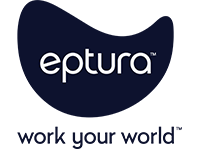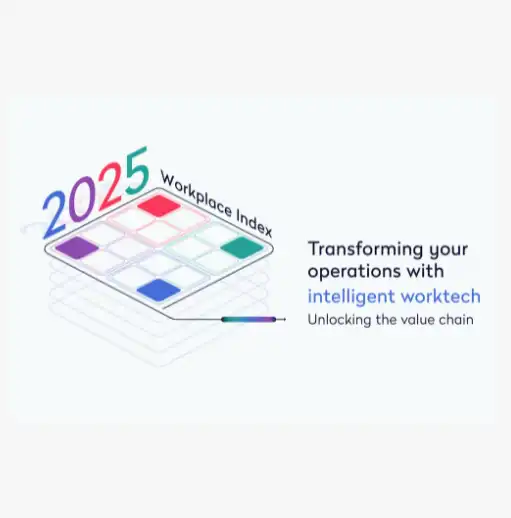
As workplace demands grow more complex, workplace leaders are under pressure to deliver smarter, more responsive environments that support employee experience while also optimizing efficiency. While overall interest in smart solutions is high, adoption rates are not meeting expectations at some organizations. To unlock the full potential of AI, companies should focus on how the technology can support the ways people work.
Workplace trends are driving the need for smart solutions
Facility leaders are navigating growing pressures as workplace activity intensifies. In fact, the number of visitors per location has nearly doubled across all regions over the past three years, placing increased strain on building infrastructure and resources. At the same time, desk bookings per building rose by 33% globally from Q1 2023 to Q1 2024, signaling a renewed demand for efficient space management as employees return to the office more frequently, according to Eptura’s 2025 Workplace Index report.
As demand grows and expectations rise, AI-backed technology can help organizations that need to optimize space and enhance employee satisfaction.
Across industries, leadership is excited about AI
According to Gartner®, “Even as worker adoption continues to lag, in the 2024 Gartner CEO and Senior Business Executive Survey, 77% of CEOs identified AI as the most impactful technology over the next three years. Moreover, nearly 90% of CIOs and technology executives reported that their enterprise will increase funding for generative AI (GenAI) in 2025 according to the 2025 Gartner CIO and Technology Executive Survey.”
The report also predicts: “By 2028, enterprises will enhance productivity by replacing 60% of SaaS workplace applications that lack GenAI-driven capabilities with those that have them.”
It also mentions, “GenAI adoption continues to lag. Only 12% of individual contributors say they’ve used GenAI for a business-critical task, and 18% say their organization supports significantly integrating GenAI into daily tasks, according to the 2024 Gartner Employee Perspectives on the Future of Work.” Many employees aren’t sure how AI fits into their daily work routines when they don’t have clear examples, training, or built-in workflows, and the result is lagging adoption rates.
Leveraging AI starts with understanding how people want to use it
The report also states, “ The mistake many organizations are making is seeing AI as just another technology to be adopted. AI is a catalyst reshaping the very nature of work itself, as humans turn to AI to:
- Augment their productivity and efficiency
- Advise them on next best actions and decisions
- Amplify their knowledge and experience”
We believe that when companies help employees position AI as a partner in decision-making and problem-solving, adoption is more intuitive and impactful.
Augmenting employee productivity and efficiency
According to the Gartner report, “Workers no longer just interact with AI; they depend on it to generate content, synthesize information and optimize workflows. GenAI and intelligent assistants are becoming indispensable for information retrieval, task completion and rapid data analysis. This shift is not just about improving efficiency; it is about freeing up human capital for higher-level cognitive functions, fostering creativity and driving strategic initiatives.”
We believe many modern workplace and facility management features already support this new dynamic by automating admin so employees can concentrate on activities that add value.
Team days
Modern scheduling simplifies the process of bringing teams together in the office. Instead of manually coordinating schedules and desk assignments, employees can set recurring team days that automatically reserve desks based on proximity, availability, and individual preferences, helping ensure colleagues are seated near one another, encouraging spontaneous collaboration and reducing administrative overhead. Supporting connection is especially valuable in hybrid environments where in-person time is limited.
Smart scheduling and natural language booking
Integrated AI helps employees book desks and rooms using everyday language. Commands like “Find a meeting room for Thursday at 2 p.m.” or “Book a desk for tomorrow” trigger instant, intelligent responses. The conversational interface removes the need to navigate complex booking systems, making scheduling more intuitive and accessible. Additional features like pattern-based reservations, hourly bookings, and shift scheduling support dynamic workforce needs across multiple locations.
Facial recognition for visitor management
Facial recognition capabilities offer a streamlined, AI-powered solution that simplifies check-ins, strengthens access control, and delivers real-time insights. By automating identity verification, facial recognition enables touchless entry, reducing wait times and minimizing manual data entry. Visitors are identified upon arrival, eliminating the need for physical badges or sign-in kiosks. The smoother, more seamless process improves operational efficiency while supporting stronger safety protocols. Organizations with high visitor volumes or sensitive access points can use the technology to maintain consistent visitor experience and security standards across locations.
When part of a larger integrated platform, facial recognition also contributes to real-time analytics, allowing facility managers to track visitor activity, monitor access patterns, and respond quickly to anomalies. These insights support compliance, enhance emergency response planning, and provide valuable data for optimizing staffing and space usage. By offloading complex identity management tasks to AI, workplace teams can focus on higher-level priorities and more strategic planning.
Advising employees on best actions and decisions
We believe intelligent workplace features are already strong use cases for AI-assisted decision-making.
Predictive maintenance
Predictive maintenance capabilities help facility teams move beyond reactive service models. Using real-time sensor data, historical maintenance records, and environmental inputs, AI algorithms identify patterns that signal potential equipment failures before they occur, empowering technicians to intervene proactively, reducing downtime and extending asset life cycles.
Intelligent dashboards and decision support
An enterprise overview dashboard helps companies automatically bring together data from bookings, assets, and visitor activity into a centralized, real-time view so workplace leaders have a comprehensive understanding of performance across multiple facilities. The unified dashboard helps identify patterns, track utilization, and monitor service delivery, enabling more confident and timely decision-making. Leaders can quickly assess which spaces are underused, which assets require attention, and how visitor traffic is trending across locations.
A key performance indicators dashboard integrates reservation data with lease and occupancy metrics to support strategic real estate planning. By surfacing trends in space usage and employee behavior, the dashboard helps organizations pinpoint opportunities to consolidate, reconfigure, or expand their footprint. These insights are especially valuable for multi-site operations, where balancing cost efficiency with employee experience requires precise, data-informed choices.
Connecting AI capabilities to real-world workflows
AI is no longer just a tool. Instead, it’s becoming a strategic partner for supporting employee workflows, from optimizing space and streamlining scheduling to amplifying decision-making and enabling predictive maintenance. Successful adoption, however, depends on more than just implementation. It also requires clear examples, embedded workflows, and a focus on employee experience. By aligning AI capabilities with real-world needs, organizations can start seeing meaningful gains in productivity, efficiency, and workplace satisfaction that match leadership enthusiasm and deliver a return on investment.
Read the full report.
GARTNER is a registered trademark and service mark of Gartner, Inc. and/or its affiliates in the U.S. and internationally, and HYPE CYCLE is a registered trademark of Gartner, Inc. and/or its affiliates and are used herein with permission. All rights reserved.
Gartner Reports: Gartner, Hype Cycle for the Future of Work, 2025, Tori Paulman, Helen Poitevin, Nate Suda, Kristin Moyer, CV Viverito, Lacy Lei, 9 June 2025
Gartner does not endorse any vendor, product or service depicted in its research publications, and does not advise technology users to select only those vendors with the highest ratings or other designation. Gartner research publications consist of the opinions of Gartner’s research organization and should not be construed as statements of fact. Gartner disclaims all warranties, expressed or implied, with respect to this research, including any warranties of merchantability or fitness for a particular purpose.




